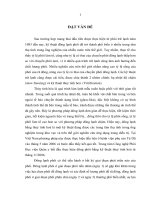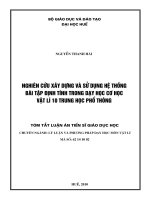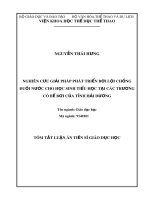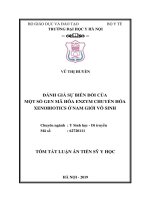tóm tắt luận án tiến sĩ bằng tiếng anh nghiên cứu biến đổi hình thái cấu trúc phôi người ngày 3, ngày 5 trước đông lạnh và sau rã đông bằng kỹ thuật thủy tinh hóa
Bạn đang xem bản rút gọn của tài liệu. Xem và tải ngay bản đầy đủ của tài liệu tại đây (193.19 KB, 31 trang )
INTRODUCTION
Freezing human embryos for later transfer is currently an
indispensible technique in every assisted reproduction center.
There have been a number of researches in attempt to improve the
survival rate of embryos after thawing and the pregnancy rate of
these embryos after transferring. Freezing techniques have also
been advanced and divided into two major groups: slow-freezing
technique and vitrification technique.
Embryo can be frozen at every stage of maturity. Freezing
embryos at pre-nucleus stage (day 1) will make it difficult to select
embryos to freeze and identify the number of embryos to thaw.
Meanwhile, it is common to freeze embryos at splitting stage (day
2 or 3) because it facilitates the selection of embryos before
freezing and after thawing based on morphological standards. As
embryos are all independent, the degenerated embryos cannot
influence healthy ones. At compacting stage (day 4), embryos are
very vulnerable. It is very difficult to assess their morphology and
thus, embryos cannot be frozen at this stage. Freezing embryos at
blastocyst stage (day 5,6,7) is more favorable than at splitting stage
because there are more cells and the degeneration of some cells
cannot influence the embryos. Several researches proved that the
survival rate and pregnancy rate of embryos frozen at day 5 are
higher than that of embryos frozen at day 6 and day 7. Embryo
freezing at blastocyst stage can also reduce the rate of multiple
pregnancies, yet the probability of embryos at blastocyst stage is
only 50-60%. It is still a controversy over the time and technique
of freezing embryos. The basis for identifying the influences of
freezing procedures and freezing time on the effectiveness of
freezing technique is the transformation of morphological structure
1
1
of embryos before freezing and after thawing. Therefore, this
research is conducted with the topic: “Transformation of
morphological structure of day-three and day-five human embryos
before freezing and after thawing by vitrification technique.”
The research aims to:
1. Describe the transformation of morphological structure of
day-three and day-five human embryos before freezing and
after thawing by vitrification technique.
2. Compare the survival rate, implantation rate, and pregnancy
rate of day-three and day-five embryos before freezing and
after thawing by vitrification technique.
Summary of new scientific contributions of thesis:
The research is conducted on 444 day-three and day-five human
embryos before freezing and after thawing by vitrification
technique, of 157 patients having in vitro fertilization from 2009 to
2012. The results show that:
- Under optical microscope, no morphological transformation
is detected between embryos before freezing and after
thawing.
- Under electron microscope, it is observed that the zona
pellucida of embryos is transformed and loses its porosity;
glycoprotein fibers are not clearly visible. Embryos that
survived after thawing show little damage; there are some
particle degeneration and vacuoles appearance at some
points in the cytoplasmic. The degenerative post-thawing
embryos show deformed cell membrane and mitochondria,
expanded endoplasmic reticulum, and shrunk nuclear
membrane.
2
2
- Survival rate and the rate of intact embryos after thawing in
day-three embryos are higher than those in day-five
embryos, with statistical significance. No statistically
significant difference is detected in between frozen day-three
embryos and frozen day-five embryos in terms of pregnancy
rate and implantation rate.
Structure of the thesis
The thesis consists of 133 pages, of which there are two pages of
Introduction, 33 pages of Literature Review, 20 pages of Research
Subjects and Methodology, 45 pages of Research Findings, 30
pages of Discussion, 2 pages of Conclusion and 1 page of
Recommendation. There is also a page list of publications and 112
references (16 Vietnamese and 96 English references).
CHAPTER 1: LITERATURE REVIEW
1.1. Principles and techniques of embryo freezing
1.1.1. Principles of embryo freezing
The principle of freezing is to reduce the temperature of the culture
containing the cell or embryo to -196
o
C. Almost all biological
activities inside the cell, including bio-chemical reactions and
metabolic activity, stop at this temperature. The cell, thus, exists in
latent form (no growth) and can be preserved for a period of time.
The materials inside the cell exist in a combined form (crystal and
glass forms) and thus, there is no internal nor external effect can
influence the cell.
While embryos are frozen and thawed, certain changes in the
culture can affect the structure, function, integrity, and survival
ability of embryos after thawing.
3
3
Like other cells, embryos can be affected by three types of damage
occurring at different ranges of temperature during freezing and
thawing procedures. At 15
o
C to -5
o
C, coldness can damage the cell
by destroying lipid drops within cytoplasmic and microtubule
structures. From -5
o
C to -80
o
C, the intracellular and extracellular
crystallization is the main cause of cell damage, which is
considered the most dangerous risk for frozen cells in general and
frozen embryos in particular. From -50
o
C to -150
o
C, the zona
pellucida or plasma membrane may be broken. During the thawing
process, the cells may suffer the same types of damage but in a
reverse order. The cell can be recrystallized, leading to the return
of intracellular crystals when the temperature increases to a level
higher than -120
o
C. Therefore, it is crucial to thaw the cells quickly
through this period and limit the possible damage to the cells.
1.1.2. Techniques of embryo freezing
Techniques of embryo freezing are classified into two major types
based on the concentration of preservatives and the speed of
freezing: (1) slow freezing and (2) vitrification.
1.1.2.1.Slow freezing
Slow freezing technique is also called speed-controlled freezing
method. Cells will be frozen at a slow speed (1-3
o
C/min), from
their physiological temperature to a very low temperature (-80
o
C),
before being preserved in liquid nitrogen. Besides, the thawing
process is also conducted slowly with a number of small steps to
eliminate freezing preservatives.
1.1.2.2.Vitrification
This technique is based on the phenomenon that water freezes
when the temperature reduces rapidly. One major factor that
affects the survival and growth ability of frozen embryos after
4
4
thawing is the formation of ice crystals. The freezing speed in
vitrification reaches 23000
o
C/min; water, hence, cannot become
ice through crystallization but transform into glass. In the form of
glass, water molecules and other solutes maintain their position
still. The advantage of this technique is that it keeps the frozen
cells from possible damage due to crystallization. The thawing
process is also conducted very fast to limit transformation from
glass to ice.
1.2. Trend of research on embryo freezing in the world and in
Vietnam
- Most researches comparing the effectiveness of freezing
techniques in the past prove that vitrification technique is
superior to slow freezing technique.
- Researches investigate the effectiveness of freezing at
different stage of embryos’ maturity, yet it is still
controversial which stage is the best for freezing.
- There are researches examining the transformation of
morphological structure and ultrastructure of embryos before
freezing and after thawing; yet the number of researches
investigating the morphological ultrastructure of embryos is
still limited while most of them are conducted on animals’
embryos and human oocytes. There has been no study on
embryos’ morphological ultrastructure in Vietnam.
- Many researches take into account the safety of vitrification
technique. Most of these researches indicate all the kids born
from frozen embryos are able to grow as normally as those
born from fresh embryos.
CHAPTER 2: RESEARCH DATA AND METHODOLOGY
2.1. Research Data
5
5
2.1.1. Subjects of the research
Subjects of the research consist of 444 embryos of 157 patients
whose embryos are frozen and thawed at day-three and day-five by
vitrification technique at the centre for Human Reproduction and
Embryology, Vietnam Military Medical University from 2009 to
2012. The embryos are divided into two groups:
- Group I: 250 frozen day-three embryos (79 patients) which
are thawed
- Group II: 194 frozen day-five embryos (78 patients) which
are thawed
Criteria to select embryos to freeze:
- Day-three embryos: level III, IV
- Day-five embryos: A, B
Criteria to exclude:
- Day-three embryos: level I, II
- Day-five embryos: C
2.1.2. Place of the research
- The centre for Human Reproduction and Embryology,
Vietnam Military Medical University
- Scanning electron microscope lab, Morphology Department,
Laboratory 69, Government Command Defending Ho Chi
Minh Mausoleum
2.1.3. Time of the research
From October 2009 to June 2012.
2.2. Research Methodology
2.2.1. Research design
The research applies analytical descriptive study.
2.2.2. Sample size and sample selection
6
6
Sample size is calculated by using the sample size formula for an
analytical descriptive study with two rates:
in which: n is the least sample size, is the confidence coefficient
( = 1.96 at 5% level of significance, = 1.28 at 10% level of
significance), and are survival rate of day-three and day-five after
thawing, respectively.
From literature review, in this research, and is chosen as 95%
(0.95) and 85% (0.85), respectively. Substitute the numbers into
the formula, we have n = 184. Therefore, both the two samples of
the research (2 groups) satisfy the least sample size requirement.
During the treatment time, there are patients who have no appeal to
preserve excess embryos, and patients who do not need to use
frozen embryos and decide to abolish these embryos because they
have enough children from transferring fresh embryos. These
excess embryos are used as templates for electron microscope, in
particular:
- For transmission electron microscope: Day-three embryos (5
fresh embryos, 5 post-thawing embryos), and day-five
embryos (5 fresh embryos, 5 post-thawing embryos)
- For scanning electron microscope: Day-three embryos (5
fresh embryos, 5 post-thawing embryos), and day-five
embryos (5 fresh embryos, 5 post-thawing embryos)
2.2.3. Methods and Techniques
- In vitro fertilization
- Embryo freezing method: Applying the Kitazato freezing
culture and fast freezing procedures by Kuwayama M.
(Japan, 2005).
- Assisted hatching technique using Tyrode acid.
7
7
- Technique to create template for electron microscopes, by
Nguyen Kim Giao (2004).
2.2.4. Morphological structure assessment methods
• Pre-freezing embryos:
- Day-three embryos: assessed by using method of Andres
Salumets (2001).
- Day-five embryos: assessed by using method of David K.
Gardner (2001).
• Post-thawing embryos:
- Intact post-thawing embryos are classified in two periods as
above. Degenerated embryos are assessed based on the level
of degeneration, according to the morphological criteria
developed by Brian Dale and Kay Elder (1997).
- All post-thawing embryos are subjected to measurement of
zona pellucida’s thickness and embryos’ size by Axio 4.8
software (Carl Zeiss). Results of measurement for post-
thawing embryos are compared with those for pre-freezing
embryos.
• Effectiveness of embryo preservation: The effectiveness of
embryo preservation is measured by:
- Survival rate of embryos after thawing: Embryos are
morphologically examine 1 hour after thawing. Survival
index is calculated as the ratio between survived cells and
the total number of cells. An embryo is considered survived
if more than 50% of its cells survive after the embryo is
thawed.
- The ability of embryos to grow in culture medium: Embryos
are assessed after 24 hours, based on survival rate (the ratio
between the number of survived embryos and the total
number of thawed embryos).
- Implantation rate.
8
8
• Pre-transferring morphological assessment:
- Day-three embryos after thawing are assessed based on the
pre-freezing embryo level, degeneration level, and the
continued split of embryos after being overnight in the
culture medium.
- Day-five embryos after thawing are assessed based on the
number of embryos with intact inner cells mass and
trophoblastic cell layer, and the number of embryos that re-
expanded after thawing
• Criteria for describing morphological structure of embryos
under scanning electron microscope and transmission
electron microscope:
- Describe the changes in the zona pellucida of pre-freezing
and post-thawing embryos (under scanning electron
microscope).
- Describe the changes in the zona pellucida, cell membrane,
cytoplasmic organelles, and cell nucleus of embryos before
freezing and after thawing.
2.2.5. Identification of pregnancy rate and implantation rate in
day-three and day-five frozen embryos after transfer
Fourteen days after embryo transfer, patients are appointed to the
Center to test the concentration of ß-hCG in the blood:
- Biochemical pregnancy: ß-hCG level exceeds 25mIU/ml by
14 days after transfer
- Clinical pregnancy: amniotic sac is detected in the uterus by
ultrasound 4-5 weeks after transfer
The implantation rate of embryos is measured by the ratio between
the number of implanted embryos and the total number of
transferred embryos.
9
9
2.2.6. Examination of factors influencing the pregnancy rate of
frozen embryos, by Menezo, 2001
2.2.7. Data processing
Data are processed by SPSS 18.0 Software, version for Windows.
2.2.8. Ethical issues in scientific research
- All research procedures are conformed to the law of
Vietnam on reproduction assistance.
- All patients, who are the subjects of the research, have
agreed and voluntarily participated in the research. All
personal information is confidential.
- Measurements are conducted only on photos; the shooting
time is no longer than 2 minutes to ensure that the embryo
quality is not affected.
- Embryos used as ultrastructure template are excess embryos
that patients voluntarily give up.
CHAPTER 3: RESULTS AND FINDINGS
3.1. Characteristics of research subjects
Table 3.1: Average age and duration of infertility of patients
Group I
(min – max)
Group II
(min – max) p
Average age
( ± SD)
31,5 ± 3,4
(24 - 40)
32,0 ± 3,6
(25 - 40)
0,08
4
Average
duration of
infertility
( ± SD)
6,4 ± 3,6
(1 - 19)
6,7 ± 4,3
(1 – 21)
0,36
2
10
10
According to the Table 3.1, there is no statistically significant
difference between the two groups in terms of average age and
duration of infertility, with p = 0.084 and 0.362, respectively.
Table 3.2: The number of periods and embryos in two research
groups
Quantity of
thawed
embryos
Percentage
(%)
Quantity of
thawing
cycles
Percentage
(%)
I 250 56,3 86 51,5
II 194 43,7 81 48,5
Total 444 100 167 100
The number of thawing cycles in group I (250 day-three embryos)
is 86 cycles, and in group II (194 day-five embryos) is 81 cycles.
3.2.Morphological structure of day-three human embryos
before freezing and after thawing
3.2.1. Changes in the thickness of zona pellucida and the
diameter of embryos before freezing and after thawing
Every embryo is measured before freezing and after thawing in
terms of the zona pellucida thickness and the embryo diameter.
The results are presented in Table 3.8 and Table 3.9.
Table 3.8: The thickness of zona pellucida in day-three
embryos before freezing, after thawing, and 1 day after
embryo culture
Time
Average thickness
of ZP (µm)
(min - max )
p
Before freezing
(1)
14,70 ± 1,13
(10,70 – 21, 30) p
1-2
=
11
11
0,306
p
2-3
=
0,308
After thawing
(2)
14,80 ± 1,20
(11,3 – 20,7)
After embryo
culture (3)
14,90 ± 1,08
(10,50 – 20,30)
Table 3.8 reveals that there is no statistically significant difference
in the thickness of zona pellucida in day-three embryos at different
phases (before freezing, after thawing, and after embryo culture),
with p > 0.05.
Table 3.9: Diameter of day-three embryos before freezing,
after thawing, and after embryo culture
Time
Average embryo
diameter (µm)
(min-max)
p
Before
freezing
(1)
147,20 ± 7,82 (132,40 –
165, 30)
p
1-2
=
0,246
p
2-3
=
0,001
After
thawing
(2)
147,50 ± 8,14 (135,50 –
158,70)
After
embryo
culture (3)
149,50 ± 6,30 (135,40 –
167,90)
There is no statistically significant difference in average diameter
of day-three embryos before freezing and after thawing.
Nevertheless, the embryo diameter after embryo culture for 1 day
is larger than that after thawing, with statistical significance (p =
0.0001).
3.2.2. Survival index and survival rate of day-three embryos
after thawing
The viability of embryos after thawing is measured by survival
index, which is equal to the ratio between the number of survived
12
12
blastomeres and the total number of blastomeres (1624/1711 =
94.92%). The survival rate of embryos is equal to the ratio between
the number of survived embryos and the total number of thawed
embryos (238/250 = 95.2%).
3.2.3. Morphology of day-three embryos before freezing, after
thawing and after 24 hours in culture medium, observed
under stereoscopic microscope
Table 3.11: Transformation of morphology of day-three
embryos before freezing and 1 hour after thawing
Embryo
level
Before freezing 1 hour after
thawing
Rate of
intact
embryos
Qua
ntity
Percentage
(%)
Quant
ity
Percentage
(%)
Level 4 99 39,6 99 39,6 100
Level 3 151 60,4 122 48,8 80,8
Level 2 - - - - -
Level 1 - - - - -
Degenerat
e 1
- - 10 4 -
Degenerat
e 2
- - 7 2,8 -
Degenerat
e 3
- - 7 2,8 -
Degenerat
e 4
- - 5 2 -
Total 250 100 250 100 -
After thawing, the number of intact embryos of level 4 is 99
embryos (100%), and of level 3 is 122 embryos (80.8%). Other
embryos have been degenerated.
13
13
Table 3.13: The rate of embryo that continues spitting after
thawing
Embryos Quantit
y
Percentage
(%)
Thawed 250 -
Survived 238 95,2
(238/250)
Continue splitting 171 68,4
(171/250)
Continue splitting after
thawing (level 4
embryos)
83 83,8
(83/99)
Continue splitting after
thawing (level 3
embryos)
70 57,4
(70/122)
The number of embryo that continues splitting is 171 embryos
(68.4%), of which there are 83 level 4 embryos (83.8%) and 70
level 3 embryos (57.4%) continue splitting after thawing.
3.2.4. Morphological ultrastructure of day-three embryos
before freezing and after thawing
3.2.4.1. Day-three embryos under scanning electron microscope
At 5000 times magnification, alternating glycoprotein fibers are
observed on the surface of day-three embryos before freezing. The
surface of day-three embryos survived after thawing is as plump as
that of pre-freezing embryos. However, at 5000 times
magnification, the post-thawing embryos show smoother surface
than the pre-freezing ones and it is difficult to detect the
glycoprotein fibers. The surface of degenerated embryos is
unevenly rough because the blastomeres are cringed.
3.2.4.2.Day-three embryos under transmission electron
microscope
14
14
At 800 times magnification, the zona pellucida, blastomeres, and
the distance between the zona pellucida and blastomeres can be
observed on day-three embryos. At 5000 times magnification, the
zona pellucida’s structure can be revealed more clearly and
separated to the blastomeres. Glycoprotein fibers can also be
detected.
Survived embryos after thawing: observing the zona pellucida at
5000 times magnification, we can see that the concentration of
electron is smoother and that glycoprotein fibers are not as visible
as in fresh embryos. Blastomeres’ structure: there is no significant
change in the cell membrane, nucleus and nuclear. Nevertheless,
vacuoles are detected and the nuclear is degenerated at some points
in cytoplasmic.
Degenerated embryos after thawing: the nucleus membrane of cells
are cringed and broken at some points. There are many folds, and
mitochondria become a substance with light color. Crested
mitochondria cannot be observed. The endoplasmic reticulum has
particles surrounding the mitochondria.
3.3.Morphological structure of day-five embryos before
freezing, after thawing and after embryo culture
3.3.1. Changes in the thickness of zona pellucida, embryo
diameter and the number of trophoblastic cells before
freezing and after thawing
Table 3.14: The average thickness of zona pellucida of day-five
embryos before freezing, after thawing and after embryo
culture
Time
Average thickness
of ZP membrane
(µm)
(min - max )
p
15
15
Before freezing
(1)
13,60 ± 1,50 (10,20
– 16, 70)
p
1-2
=
0,107
p
2-3
=
0,001
After thawing (2) 12,40 ± 1,30 (9,7 –
17)
After embryo
culture (3)
10,90 ± 1,75 (8,30 –
15,70)
The average thickness of zona pellucida of day-five embryos
before freezing and after thawing are not significantly different,
with p = 0.107. However, after 1 day of embryo culture, the zona
pellucida’s thickness reduces considerably in comparison to that in
post-thawing embryos, with p = 0.001.
Table 3.15: Average diameter of day-five embryos before
freezing, after thawing, and after embryo culture
Time
Average embryo
diameter (µm)
(min-max)
p
Before freezing
(1)
153,50 ± 9,40 (133,3 –
185,00)
p
1-2
=
0,537
p
2-3
=
0,001
After thawing (2) 152,70 ± 9,80 (137,50
– 187,50)
After embryo
culture (3)
161,70 ± 19,50 (138,40
–198,20)
The average diameter of day-five embryos before freezing and
after thawing are not significantly different, with p = 0.537.
However, after 1 day of embryo culture, the embryo diameter
reduces considerably in comparison to that in post-thawing
embryos, with p = 0.001.
Table 3.16: The number of trophoblastic cells on a slice of day-
five embryos before freezing, after thawing, and after embryo
culture
The average number of p
16
16
Time trophoblastic cells
(min-max)
Before freezing
(1)
7,09 ± 1,12 (5 – 9) p
1-2
=
0,009
p
2-3
=
0,001
After thawing (2) 6,97 ± 1,7 (0 – 9)
After embryo
culture (3)
9,64 ± 3,02 (0 –20)
The average number of trophoblastic cells on a slice of day-five
embryos after thawing reduces significantly in comparison to that
before freezing (p = 0.009). However, this number sharply
increases after 1 day of embryo culture, with p = 0.001.
Table 3.17: Rate of survival, intactness, and degeneration of
day-five embryos after thawing
Embryos Quantit
y
Percentage
(%)
Intact 137 70,6
TE and ICM partially
degenerated
21 10,8
TE partially degenerated 10 5,2
ICM partially degenerated 5 2,6
Fully degenerated 21 10,8
Total 194 100
The number of survived embryos after thawing, including intact
embryos and partially degenerated embryos (a part of TE
(trophetoderm) and/or ICM (inner cell mass) is degenerated), is
173 embryos (173/194 = 89.1%). The percentage of intact embryos
is 70.6%.
3.3.2. Morphology of day-five embryos before freezing and
after thawing, observed under stereoscopic microscope
Table 3.18: Transformation of morphology of day-three
embryos before freezing and after thawing
17
17
Embryo
maturity
Before freezing Survived after
thawing
Quantit
y
Percentag
e (%)
Quantit
y
Percentage
(%)
1
AA 1 0,5 1 0,6
AB 1 0,5 1 0,6
BA - - - -
BB - - - -
2
AA 27 13,9 27 15,6
AB 52 26,8 50 28,9
BA 10 5,2 10 5,8
BB 16 8,2 11 6,4
3
AA 33 17,1 33 19,0
AB 30 15,5 24 13,8
BA 8 4,1 6 3,5
BB 16 8,2 10 5,8
Total 194 100 173 100
After thawing, all 1AA, 2AA, 3AA embryos survived while there
are two 2AB and two 3BA embryos degenerated. Regarding 2BB,
3AB, and 3BB embryos, six embryos of each type degenerated
after thawing. The total number of survived embryos is 173.
3.3.3. Morphological ultrastructure of day-five embryos before
freezing and after thawing
3.3.3.1. Day-five embryos under scanning electron microscope
It is observed that fresh day-five embryos are spherical, with ZP
membrane’s glycoprotein fibers on the embryo surface. The
surface of survived embryos after thawing is still rounded but the
ZP membrane is smoother and glycoprotein fibers are less visible
than those of fresh embryos. The surface of degenerated embryos
after thawing is unevenly rough because the blastomeres are
degenerated and make the embryo cringed.
18
18
3.3.3.2. Day-five embryos under transmission electron
microscope
At 800 times magnification, the zona pellucida, flat trophoblastic
cells, fluid cavity, and the part of ICM can be observed on day-five
embryos before freezing. At 10,000 times magnification, the zona
pellucida of fresh day-five embryos is detected with glycoprotein
fibers. At 4,000 times magnification, the inner cell and
trophoblastic cells of fresh day-five embryos are seen with
membrane, cytoplasmic, nucleus, and such organelles as
mitochondria, endoplasmic reticulum, and glycogen particles, etc.
Intact embryos after thawing: the zona pellucida is clearly
observed; trophoblastic cells are close to the zona pellucida and
ICM; the linkage among these cells is very strong; and the color of
trophoblastic cells is lighter than that of ICM. At 10,000 times
magnification, the electron density of the zona pellucida decreases
and glycoprotein fibers are not as visible as in pre-freezing
embryos.
At 4,000 times magnification, trophoblastic cells and ICM of day-
five embryos survived after thawing do not change in terms of the
cell membrane, nucleus, cytoplasmic mitochondria, and
endoplasmic reticulum. Nevertheless, the electron density in these
cells decreases and there appear vacuoles and some degenerated
points in the cytoplasmic.
3.4.Survival rate, implantation rate, and pregnancy rate of
frozen embryos
Table 3.24: A comparison between day-three and day-five
embryos preserved by vitrification technique
Criteria Day-
three
Day-
five
OR
(95%CI)
19
19
embryos embryo
s
;
p
Average
number of
transferred
embryos
2,70 ±
1,10
(1 – 5)
2,17 ±
1,02
(1 – 4)
p =
0,001
Average
thickness of
uterine lining
(mm)
10,06 ±
1,41
(6 – 14)
10,13 ±
1,90
(7 – 14)
p = 0,95
Average
preserving
duration
(months)
7,64 ±
5,67
(0,87 –
30,5)
8,33 ±
6,17
(2,0 -
33,9)
p =
0,068
Survival rate
(%)
95,2 89,2 2,41
(1,10 –
5,36)
p =
0,016
Intact embryo
rate (%)
88,4 70,6 3,17
(1,88 –
5,36)
p =
0,001
Implantation
rate (%)
14,7 16,6 0,86
(0,48 –
1,54)
p = 0,6
Transfer cycle
rate (%)
100 95,1 p = 0,11
Pregnancy
rate(%)
34,9 32,5 1,11
(0,55 –
2,25)
p = 0,74
20
20
Accumulated
pregnancy rate
(%)
34,2 32,4 1,08
(0,52 –
2,24)
p = 0,82
From the above table, it can be seen that there is no statistically
significant difference between the two groups in terms of the
average thickness of uterine lining and the preserving duration.
The number of transferred embryos is significantly higher in day-
three embryos group, with p = 0.001. The survival rate and intact
embryo rate of day-three embryos is also higher than that of day-
five embryos, with p < 0.05. There is no statistically significant
difference between the two groups in terms of transfer cycle rate,
pregnancy rate, and accumulated pregnancy rate.
CHAPTER 4: DISCUSSION
4.1. Morphological structure of embryos before freezing and
after thawing
4.1.1. Under optical microscope
The thickness of zona pellucida and embryo diameter of embryos
before freezing and after thawing
Table 3.8 and table 3.14 show that the changes in morphological
structure of day-three and day-five embryos before freezing and
after thawing are not statistically significant. Yi-Fan Gu et al
(2010) examine 103 fresh embryos and 123 post-thawing embryos
by observing the zona pellucida of embryos under light-polarized
microscope. Finding that the zona pellucida is structured with 3
layers, the authors measure the thickness of each layer and the total
thickness of all layers in embryos before freezing and after
thawing. The results show no statistically significant difference
21
21
between pre-freezing and post-thawing embryos in terms of the
thickness of each layer and the total thickness of all layers.
However, in our research, we find that the average thickness of
zona pellucida of day-three embryos is 14.7 ± 1.13 µm, which is
lower than that in the research of Yi-Fan Gu et al (2010) (19.20 ±
2.52 µm). This difference may result either from the difference
between Vietnamese patients’ embryos and foreigners’ embryos or
from the variance between Yi-Fan Gu’s research and our research
in terms of patients’ age structure. The results of our research are
consistent to those of Sifer C. et al (2006) and Van Den Abbeel E.
(2000) with regard to the indifferent thickness of zona pellucida of
pre-freezing and post-thawing embryos. Therefore, vitrification
technique is proved to be superior to slow freezing technique
because the embryos’ zona pellucida is not damaged during the
process of freezing and thawing by vitrification technique.
Table 3.9 and table 3.15 show that the average diameter of day-
three and day-five embryos after thawing is not statistically
different from that before freezing, with p > 0.05. Hence, it can be
concluded that the freezing process and the preserving culture
applied in this research are stable and credible. It is observed that
the diameter of embryos after overnight embryo culture increases
significantly in comparison to that of embryos after thawing, which
proves that the embryos continue growing after thawing. This
result supports the application of pipet of the same size for pre-
freezing and post-thawing embryos; yet for post-culture embryos,
it is necessary to use pipet of larger size to avoid injury to
embryos.
Morphological structure of embryos before freezing and after
thawing
22
22
- Day-three embryos: Table 3.11 reveals that the 100% of
level 4 embryos are intact after thawing while only 80.8% of
level 3 embryos are intact after thawing. This result is
consistent with that of Martin D. et al (2006), showing that
the degeneration rate increases when the rate of cytoplasmic
fragments exceeds 20%. These fragments are taken out of
the embryos by micromanipulation technique to improve the
quality of these embryos. Mandelbaum J. (1987) finds that
the degeneration rate increases when the rate of cytoplasmic
fragments rises; in particular, at 40% rate of cytoplasmic
fragments, the degeneration rate is 33% while this rate is
only 20% at 10% rate of cytoplasmic fragments.
Mandelbaum J also indicates that the embryo maturity, the
number of cells and the uniformity of blastomeres do not
affect the quality of embryos after thawing. Martin D. et al
(2006) suggests that cytoplasmic fragments shrink the
viability and the implantation rate of embryos.
- Day-five embryos: All pre-freezing and post-thawing
embryos are classified by the embryo assessment method of
David Gardner (2001). In this research, most pre-freezing
embryos are at level 2 or 3 in terms of the elongation of
embryos; there are two embryos of level 1 and no embryos
of level 4,5, and 6. Table 3.18 demonstrates that AA
embryos have the highest survival rate in comparison to AB,
BA, and BB embryos. The survival rate of level 2 embryos
(in terms of elongation) is 93.3%, statistically higher than
that of level 3 embryos, with p = 0.037. The reason may be
the larger fluid cavity and embryo size of embryos with
higher level of elongation, which influence the preservatives
absorption of cells and decrease the survival rate of
23
23
embryos. Hyon-Jun Cho et al (2002) investigate 121
embryos frozen by vitrification technique with the electron
microscope cooper grids. The authors, based on the growth
of embryos, divide blastocysts into 4 stages to assess the
survival rate of embryos after thawing: (1) early stage
blastocyst whose size is less than 140 µm, (2) early
expanding blastocyst whose size is from 140 µm to 160 µm,
(3) expanding blastocyst whose size is from 160 µm to 180
µm, and (4) fully expanded blastocyst whose size is more
than 180 µm. The survival rate of embryos with respect to
the four stages is 86.5%, 91.7%, 75.8%, and 77.8%,
respectively. The rate of embryos survived after thawing is
highest when blastocysts are expanding at early stage. The
authors also provide recommendations to improve the
survival rate of post-thawing embryos when blastocysts have
fully expanded, by reducing the fluid cavity in the embryos.
The result is, the survival rate of expanded embryos
increases significantly after the fluid cavity is diminished.
- Pierre Vanderzwalmen (2002) examine 61 freezing periods
of day-five embryos, corresponding to 177 frozen embryos,
of which there are 55 embryos at early stage, 41 embryos at
expanding stage, and 71 embryos at fully expanded stage.
The survival rate of early stage embryos, expanding
embryos, and fully expanded embryos is 54.5%, 58.5% and
20.3%, respectively. The corresponding pregnancy rate is
22.7%, 23.5%, and 4.5%, respectively. The author shows
that the survival rate and pregnancy rate of fully expanded
embryos are statistically lower than those of expanding
embryos due to the influence of fluid cavity. Hence, in order
to ensure high quality of embryos after thawing, it is crucial
24
24
to select relevant embryos for freezing so that the patients
can save money and time while the doctors can save time
and effort. The above researches show that as for day-three
embryos, the rate of cytoplasmic fragments is the criterion to
determine the survive rate of the embryos after thawing and
the probability of success after implantation. As for day-five
embryos, we can base on the elongation of embryos, and the
characteristics of the inner cells and trophoblastic cells to
select high quality embryos at early stage or when the fluid
cavity in the embryo is still small (AA, AB, BA embryos).
BB embryos have the survival rate of only 65.6%. Thus, it is
very likely that there will be no embryo to transfer after
thawing if the number of embryos before thawing is small
while they are all BB embryos. This result can help facilitate
pre-treatment consultation.
4.1.2. Under electron microscope
In this research, we utilize the excess embryos that patients do not
require preservation and embryos that patients voluntarily give up
because they already have enough children. Therefore, the number
of embryos for examination under electron microscope is very
small. We hope that this research, with only some case studies, can
serve as a basis for further studies.
• Embryo morphology under scanning electron microscope
It is difficult to detect glycoprotein fibers and some holes on the
surface of post-thawing embryos. Adirekthaworn A. et al (2008)
examine the structural changes in the zona pellucida of pig oocytes
before freezing and after thawing, by using scanning electron
microscope. The author shows that there are some holes and
cavities created by the glycoprotein fibers on the surface of fresh
oocytes. However, on the surface of post-thawing oocytes, it is
25
25









